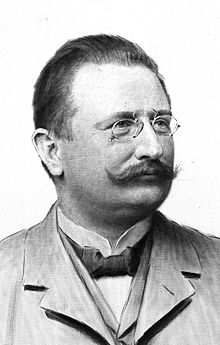Otto Kern

Otto Ferdinand Georg Kern (14 February 1863 in
Biography
Early life
Otto Kern was born near
Career
In the following years (from 1889) he worked as an archaeologist in Italy, Greece and Asia Minor. From 1889 to 1891 he was a scholarship holder of the German Archaeological Institute (DAI) and was able to travel the Mediterranean region. From 1891 he dug together with Carl Humann in the ancient city of Magnesia at the Mäander. He also dealt with this city in his postdoctoral thesis on the history of the foundation of Magnesia on the Maeander from 1894.[1][2]
In 1894 he qualified as a private lecturer for classical philology in Berlin, where he also worked as an assistant in the sculpture department of the
In 1922 he refused a call to the University of Hamburg. Before his retirement in 1931 he travelled 1925-1926 again to Thessaly. He received two honorary doctorates from the University of Halle:
- 1929 from the Faculty of Law and Political Science,
- 1930 from the Faculty of Theology.
Later life and death
In 1937 he was elected a corresponding member of the Göttingen Academy of Sciences.[4]
Kern became a member of the right-wing radical German Fatherland Party and then of the German National People's Party (DNVP).[5]
Otto Kern died on 31 January 1942 at the age of 78. Parts of his estate are in the possession of the Göttingen University Library (Wilamowitz biography), the Central Archive of the National Museums in Berlin (materials on the Pozzo drawings) and the Archive of the German Archaeological Institute (a letter).
Works
Among his better written efforts was a three part work on the religious history of ancient Greece, "Die Religion der Griechen" (1926–38):
- Vol. 1. Von den Anfängen bis Hesiod – Prior to Hesiod.
- Vol. 2. Die Hochblüte bis zum Ausgange des fünften Jahrhunderts – The Golden Age up until the start of the 5th century BC.
- Vol. 3. Von Platon bis Kaiser Julian – From Emperor Julian.
Other significant works by Kern include:
- Die Gründungsgeschichte von Magnesia am Maiandros, 1894 – The founding history of Magnesia on the Maeander.
- Beiträge zur Geschichte der griechischen Philosophie und Religion (with Paul Wendland), 1895 – Contributions to the history of Greek philosophy and religion.
- Ueber die Anfänge der hellenischen Religion, 1902 – On the beginnings of Hellenic religion.
- Eleusinische Beiträge, 1909 – Eleusinian contributions.
- Nord-griechische Skizzen, 1912 – Sketches of northern Greece.
- "Inscriptiones Graecae", 1913.
- Orpheus. Eine religionsgeschichtliche Untersuchung, 1920 – Orpheus; a religious-historical study.
- "Orphicorum fragmenta", 1922.[6][7] Internet Archive.
References
- ^ Otto Kern @ NDB/ADB Deutsche Biographe
- ^ a b Catalogus Professorum Halensis Biographical sketch
- ^ Vgl. Otto Eißfeldts Nachruf, in: Historische Zeitschrift 166, 1942, S. 219 f., hier insbesondere S. 220.
- ISBN 3-525-82516-1S. 130
- ISBN 3-89812-150-XS. 379.
- ^ WorldCat Identities Most widely held works by Otto Kern
- ^ German Wikisource Bibliography of Otto Kern
